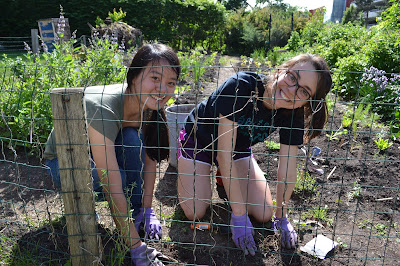The Cultivating Community Garden, before planting
Catherine and Masha planting pole beans, which ended up being eaten by the bunnies.
Those darn bunnies - if only they weren't so cute!
We tried a bunch of natural pest control, like these ladybugs we ordered for the garden!
The home we made for the ladybugs. Unfortunately, they didn't stay, despite bountiful food (aphids).
Allyson applying "garlic tea" to young pac choi plants.
Catherine making a garlic/pepper spray to put on the cabbage.
Companion planting can also be used to help with pest control. Borage, pictured here, is a companion plant for strawberries, tomatoes, and squash. Added bonus - the flowers are edible!
We took a couple field trips. We went to Rowe's Produce Farm in Ypsilanti, MI. It was great! We all came home with big flats full of sweet berries. Mine were all gone within a week, since I made two strawberry rhubarb pies. Some attendees still have some frozen a couple months later!
We went to the 16th Annual Tour of Detroit Urban Gardens & Farms and went on a tour called "Fresh Perspectives," which was about youth gardens. At Feedom Freedom, a girl explained the container of straw at the opening of the bee hive. The bees need to be able to drink, but if you just give them a container full of water, they can drown. The straw helps them out.
The Genesis Lutheran Church Garden, where high school students learn important business skills by taking care of the garden and selling their produce at a farm stand.
The kids at Focus: HOPE were happy to help us out in the garden. They showed off their knowledge of what plants need on the first day, giving us answers like "carbon dioxide" and talking about using fish as fertilizer.
Russia planting cucumber in the pickle bed.
Khari, Bradley, and Kobe eating homemade salsa with chips donated from the Ann Arbor Tortilla Factory.
We love our volunteers! Thanks to everyone who helped out in the garden this summer.
Shelby found a pumpkin.
Will cooked up some chard.
Theresa harvested some garlic scapes.
And the garden was beautiful!




















